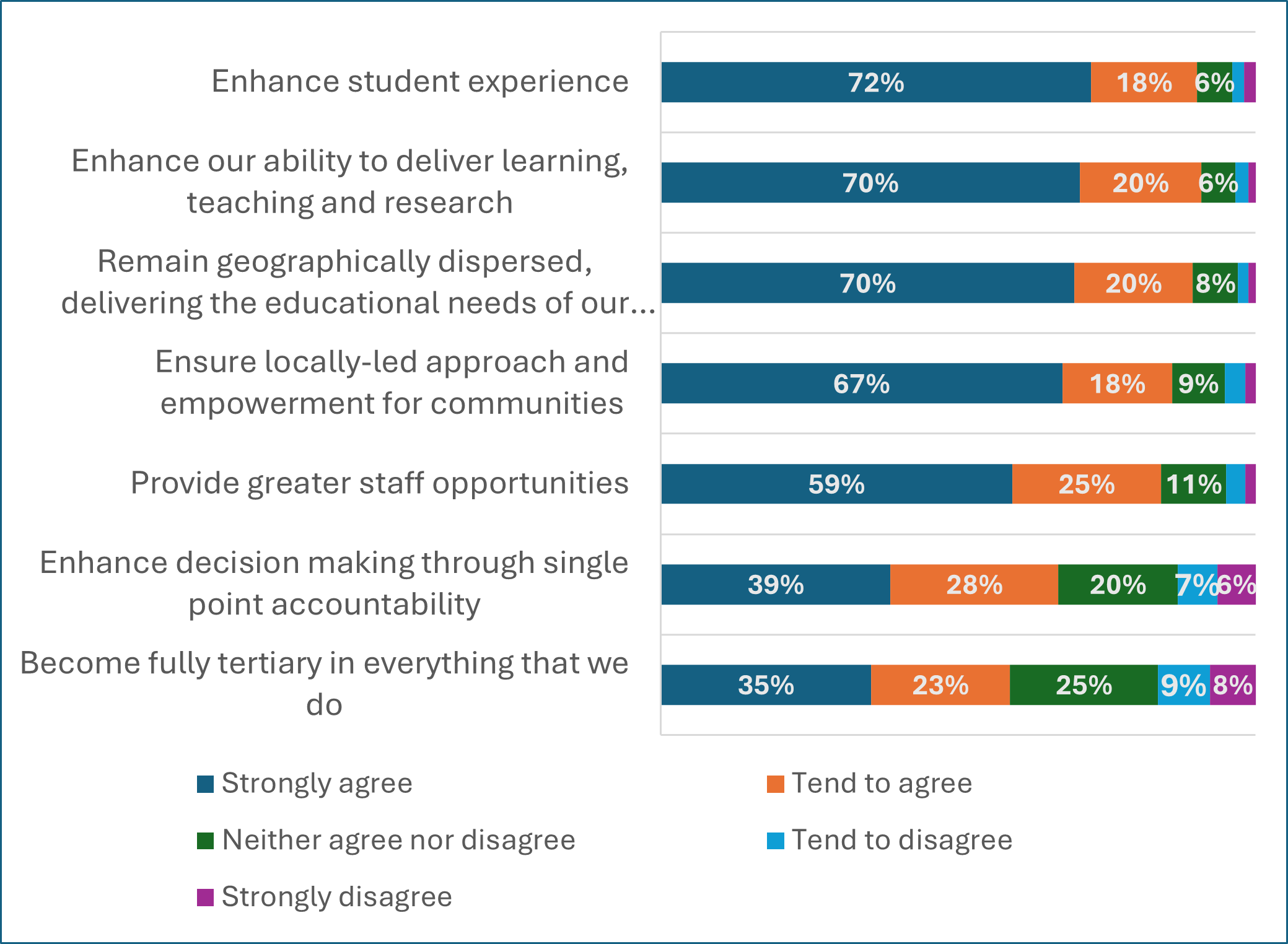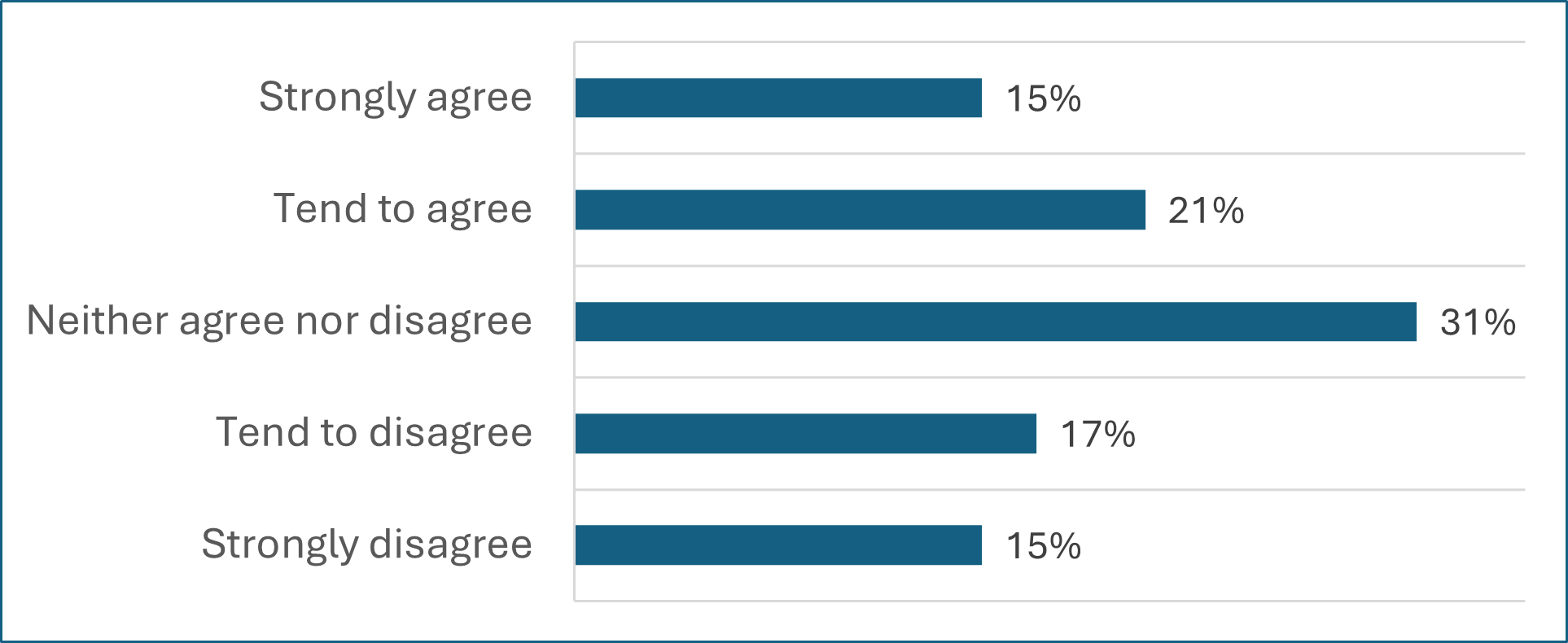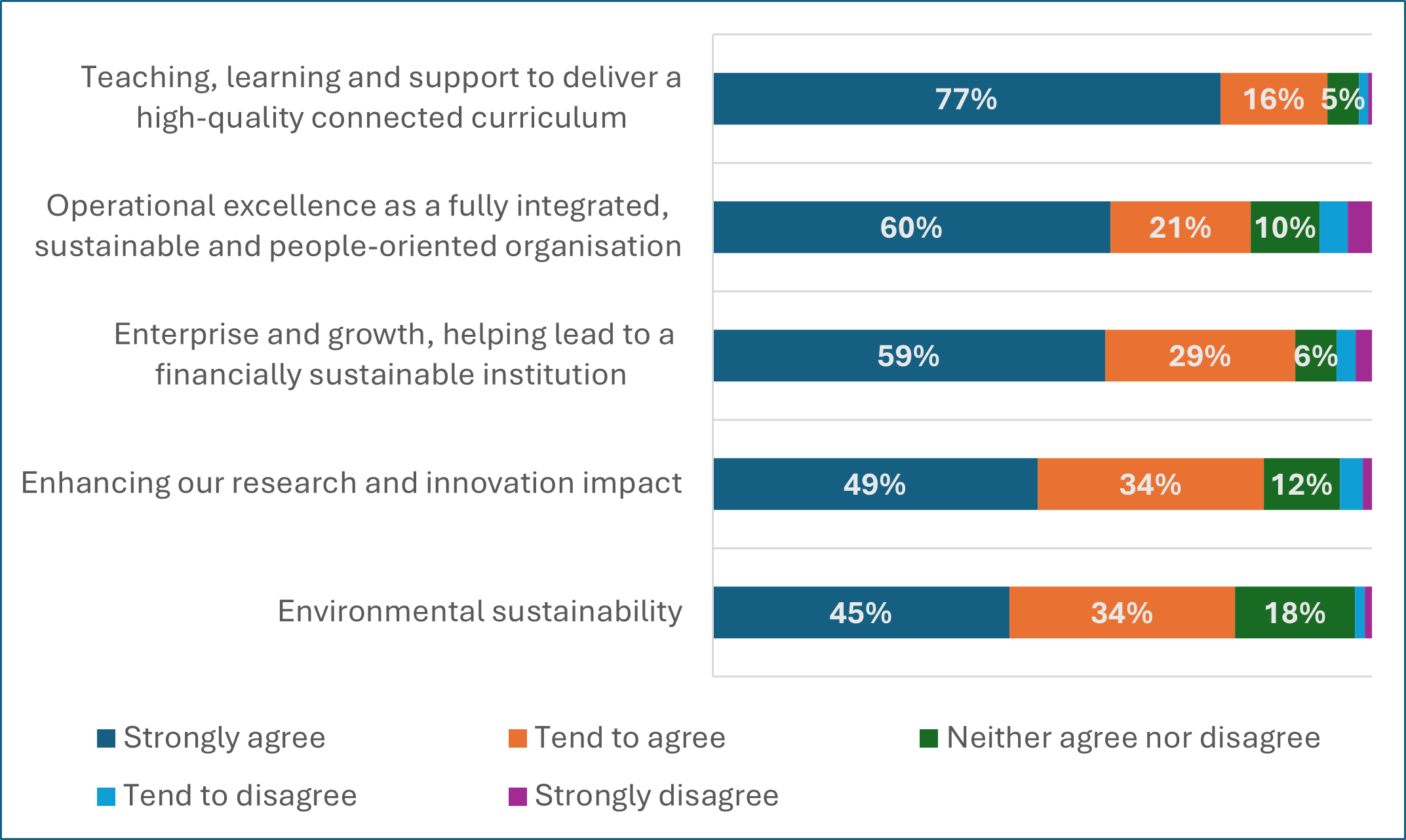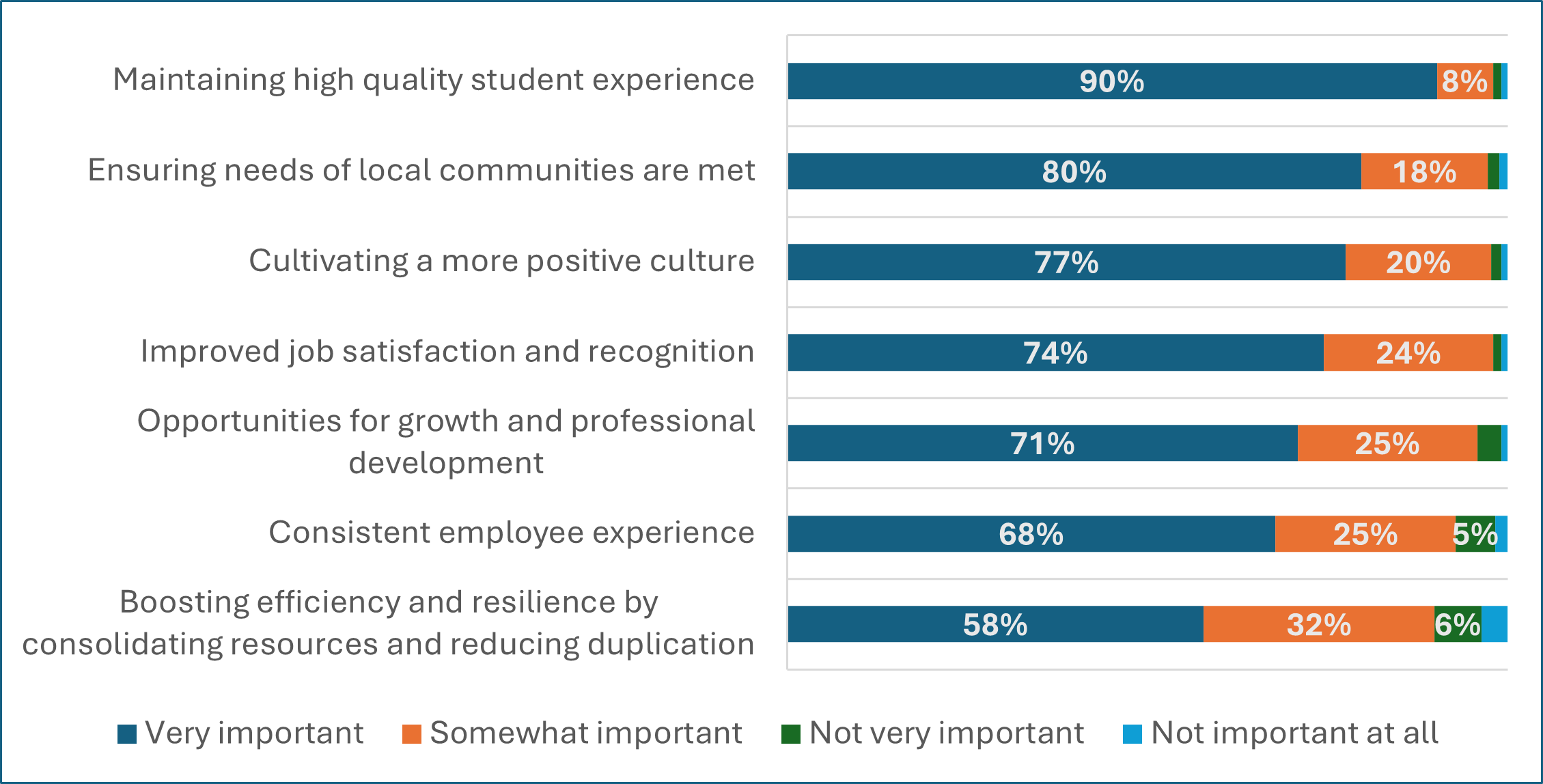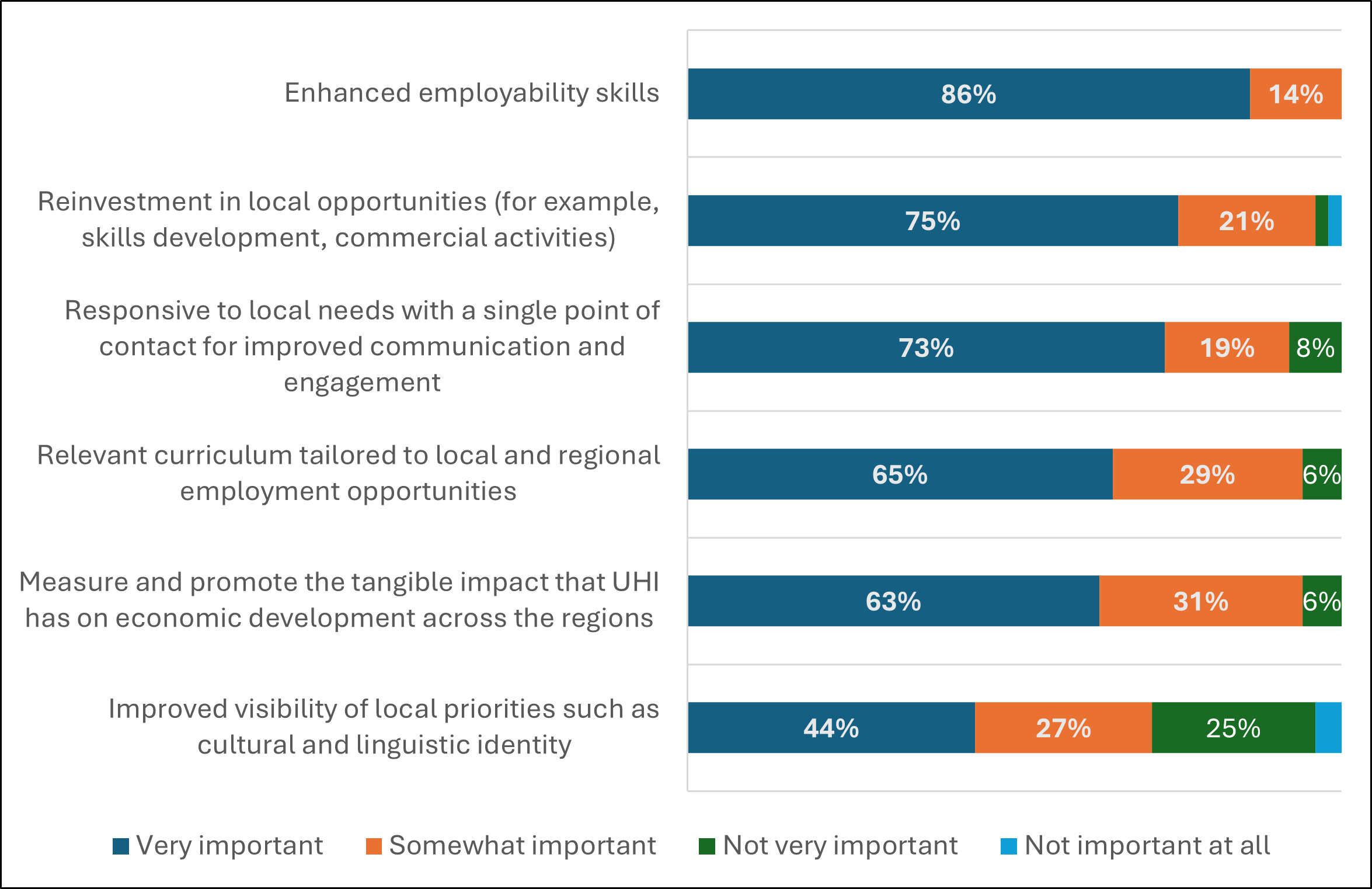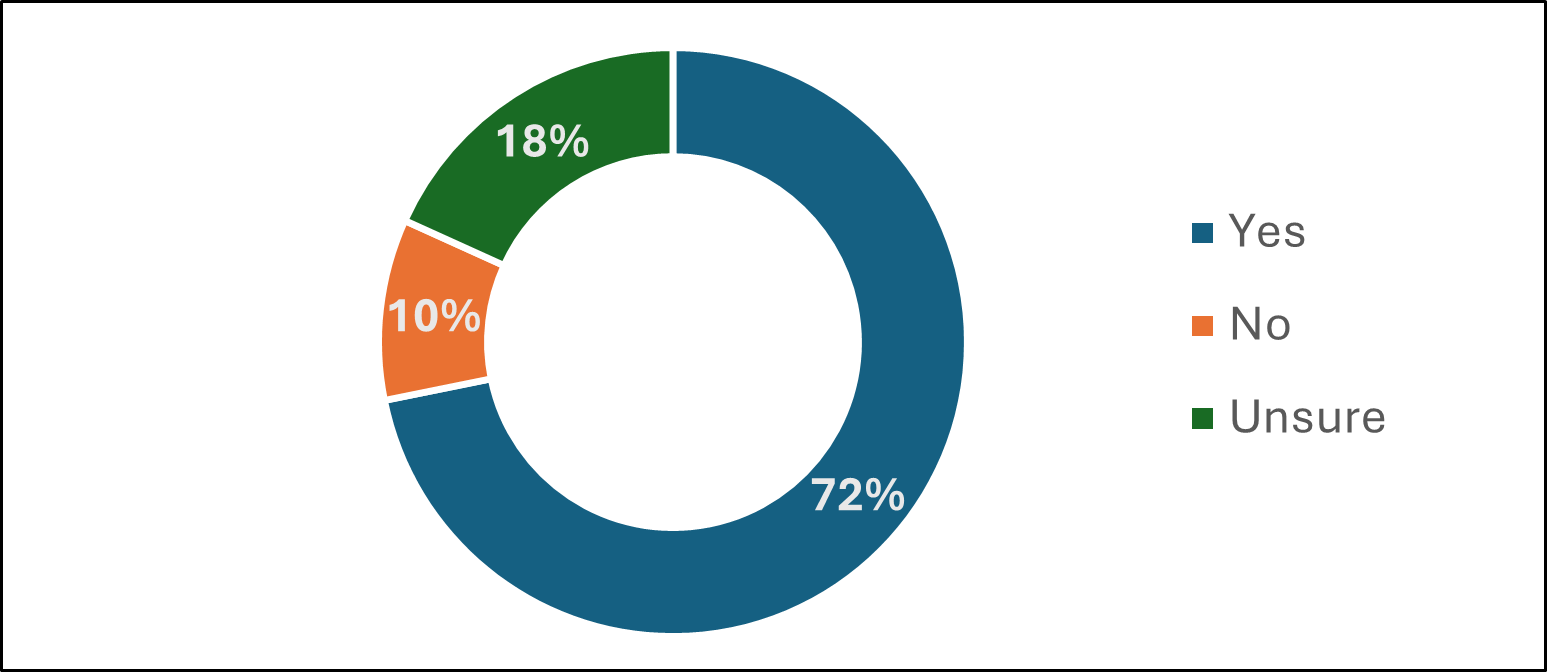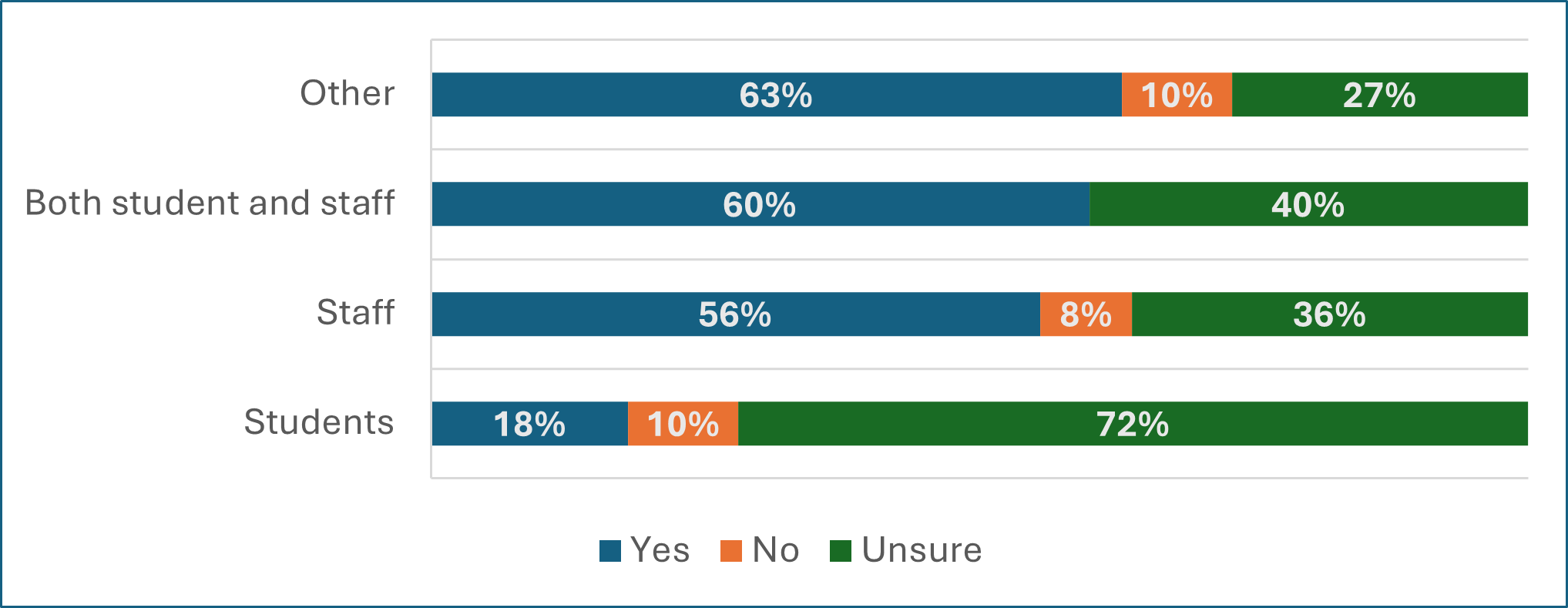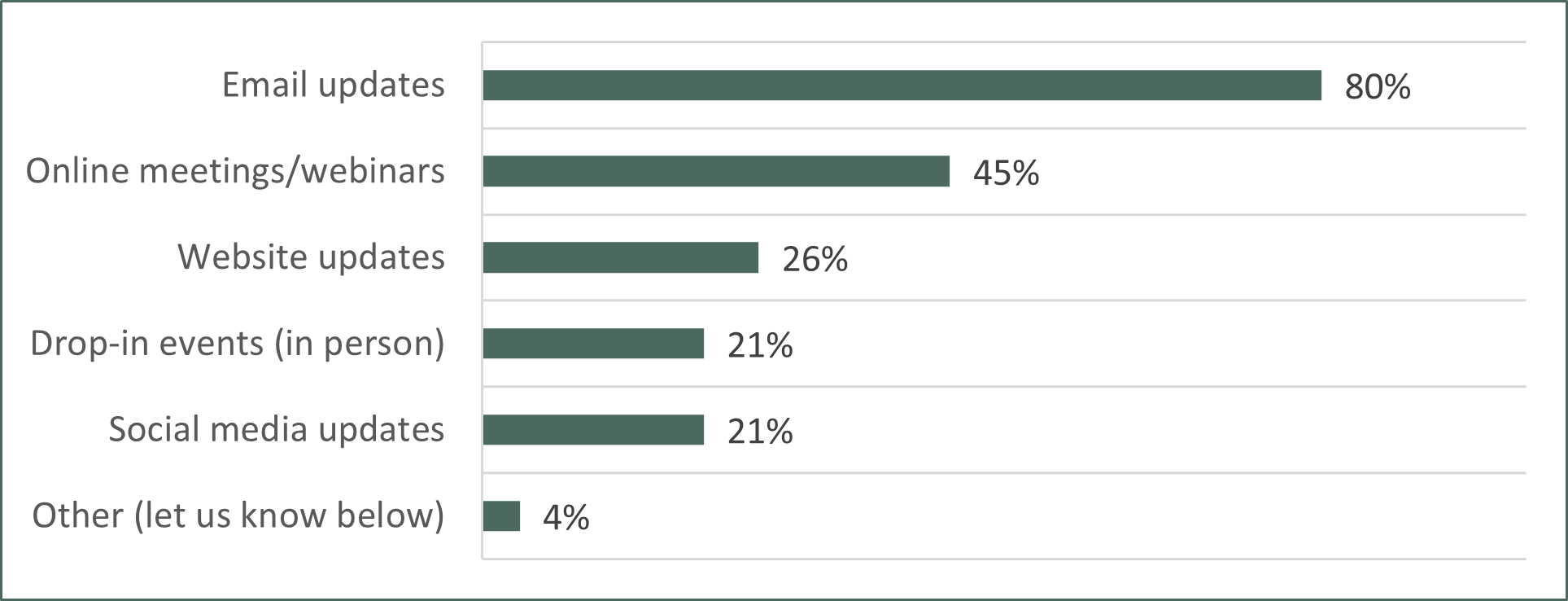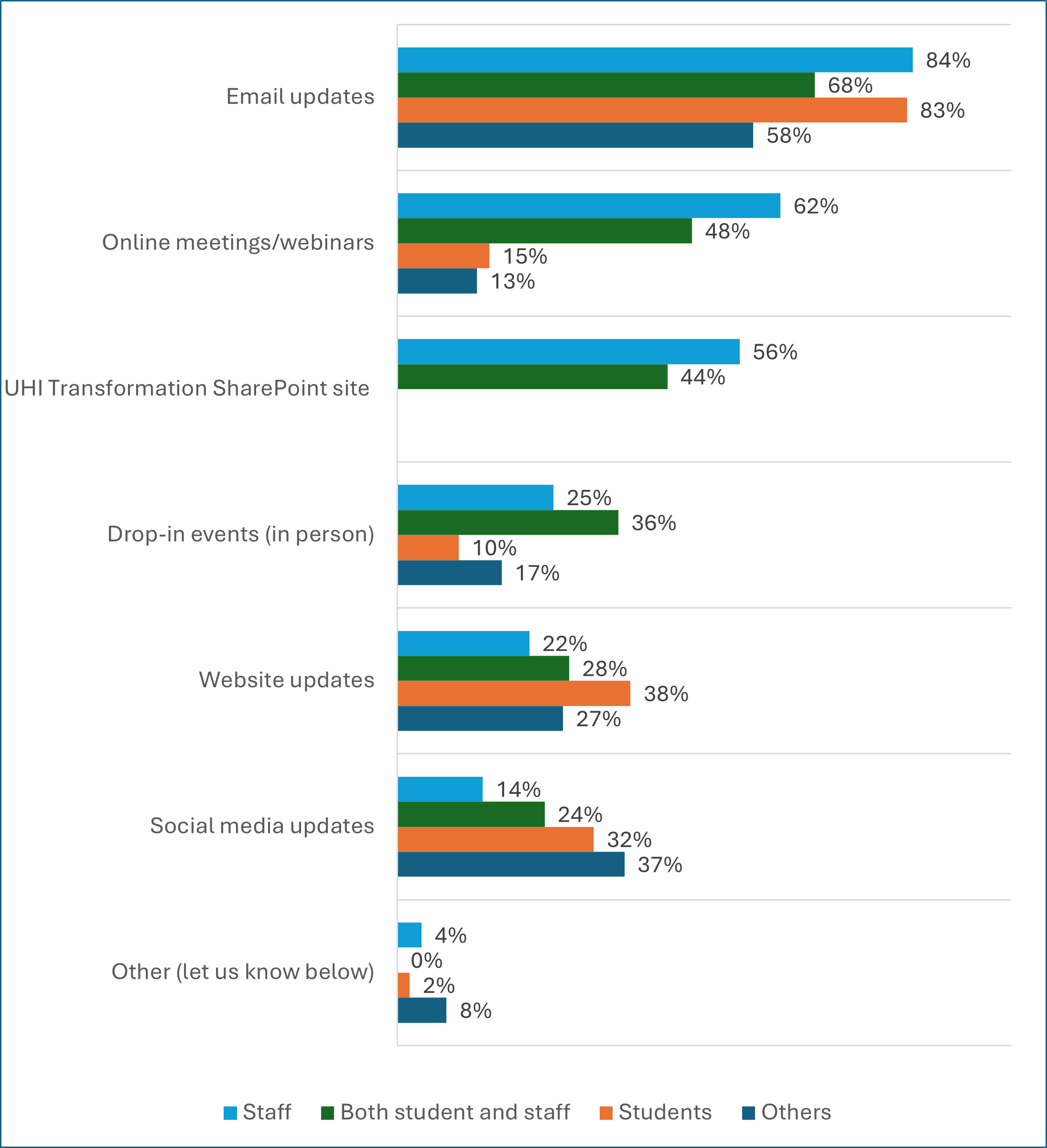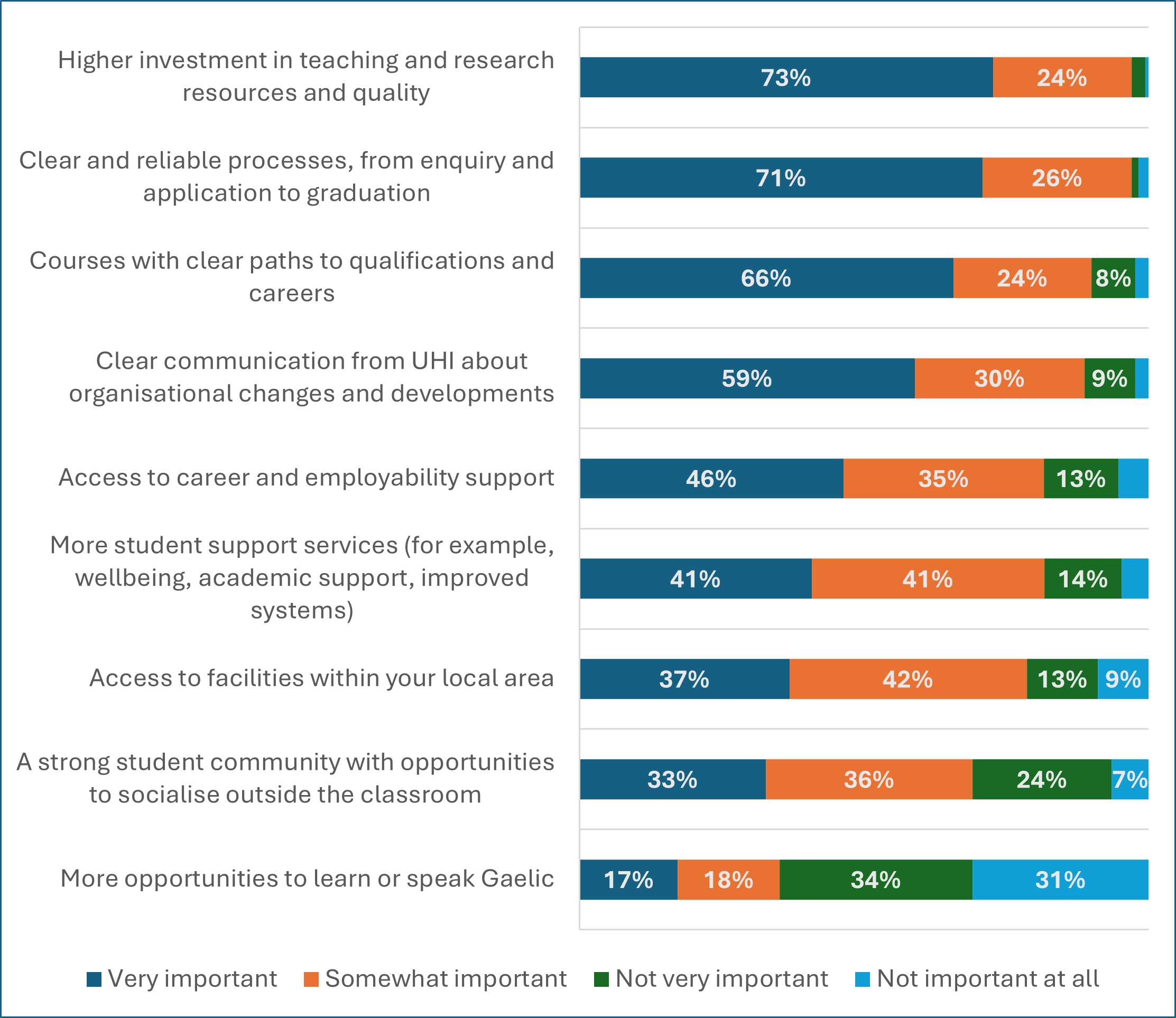Engagement
Background
Between April and May 2025, UHI conducted a formal engagement initiative with students, staff and other key stakeholders to gather feedback on our early proposals for a more integrated partnership. This process generated a substantial volume of quantitative and qualitative data, including nearly 1,500 text-based responses. These insights enabled a robust and comprehensive analysis, which has helped inform the development of a new operating model.
This page presents a summary of that analysis. Both the full report and its summary were produced by the Diffley Partnership, who led the independent analysis of the UHI Transformation engagement programme.
You can read the summary on this web page, or download the engagement summary as a pdf. The full report is also available for download.
Purpose of the Research
Engagement was conducted by the University of the Highlands and Islands (UHI) as part of the development of its Transformation programme. The aim of this transformation is to establish a more integrated, efficient and sustainable tertiary education institution serving the Highlands and Islands, Moray and Perthshire regions.
UHI engagement sought to gather stakeholder feedback on early proposals, understand perceptions of integration and transformation and inform the next phase of work toward a Full Business Case (FBC).
Methodology
UHI designed a mixed-methods engagement programme combining:
- An online survey (551 valid responses),
- Focus groups (staff, students, practitioners),
- Online and face-to-face meetings (20–30 events),
- Informal engagement (e.g., via the student association, social media).
Between the 11 UHI partners there are 2,500 staff members, 36,000 students and around 50 learning centres. The regions across the Highlands and Islands, Moray and Perthshire include seven local authorities and nine health boards, spanning across two-thirds of Scotland.
Table 1: Sample profile
| Responder type/location | Number of respondents | Percentage of total respondents |
|---|---|---|
| Total | 551 | 100 |
| Relationship to the UHI partnership | ||
| Student | 144 | 26 |
| Staff | 325 | 60 |
| Both student and staff | 25 | 5 |
| Other | 52 | 9 |
| UHI Partner | ||
| UHI Argyll | 50 | 9 |
| UHI Inverness | 109 | 20 |
| UHI Moray | 45 | 8 |
| UHI North, West and Hebrides | 101 | 18 |
| UHI Orkney | 43 | 8 |
| UHI Perth | 90 | 16 |
| UHI Shetland | 36 | 7 |
| Highland Theological College (HTC) | 3 | 1 |
| Sabhal Mòr Ostaig | 5 | 1 |
| Scottish Association for Marine Science (SAMS) | 7 | 1 |
| Directly enrolled with the University of the Highlands and Islands (UHI) – including Centre for History and Centre for Rural Health Sciences | 6 | 1 |
| UHI Executive Office | 87 | 16 |
| Not sure/Unsure | 5 | 1 |
Survey participants included staff, students, both student and staff, and other stakeholders, with representation from all UHI partners; the sample profile is included within Table 1.
The Diffley Partnership were commissioned to analyse survey responses and notes by UHI from staff engagement sessions.
Quantitative analysis was conducted for the closed survey responses. Qualitative analysis included thematically coding feedback from staff sessions and conducting thematic analysis of the survey results.
While findings are robust, the open nature of the survey means the sample is non-probability and cannot be generalised to the full UHI population.
Staff Engagement Sessions
Main themes included:
- Uncertainty about mergers: Staff raised concerns about guiding principles for mergers, fairness in employment terms, and lessons learned from previous mergers, particularly UHI NWH.
- Lack of transparency and clarity: Many were unclear on the content, authorship, and decision-making processes around the Full Business Case (FBC).
- Divergent views on transformation options: Clarification was sought on specific models (Options 3, 4, 5, and 6), with some favouring an incremental or hybrid approach.
- Concerns over decision-making power: Staff questioned whether non-transforming partners would influence decisions affecting the whole network.
- Career development and equity: There were strong calls for standardised pay, promotion pathways, and better support for professional growth.
- Job security and role changes: Fears about redundancies and role consolidations were prominent, alongside questions about remote working and local delivery arrangements.
- Terms and conditions: Staff expressed anxiety over potential impacts on employment contracts, pensions and national bargaining frameworks including the contractual tensions that exist within the UHI partnership's tertiary arrangement.
Perceptions of Transformation
UHI delivering mission: More than half of survey respondents agreed UHI is achieving its mission of having 'a transformational impact on the people, communities and economy of its regions' and incorporating its four founding principles. However, a fifth disagreed (see Figure 1).
In reply to open-text questions on what improvements the UHI partnership should make to better fulfil its mission and uphold its founding principles, there were calls to improve alignment with community and industry needs, deliver more responsive curricula and foster stronger internal collaboration.
Figure 1: Do you agree the UHI partnership is currently delivering on its mission of having 'a transformational impact on the people, communities and economy of its regions' and incorporating its four founding principles? [Base: Staff, Both student and staff, Other (407)]
Necessary principles for transformation: The survey found strong agreement with all of the listed principles, especially enhancing student experience and remaining geographically dispersed. Lower levels of support were found for single-point accountability and full tertiary alignment (see Figure 2).
Figure 2: Do you agree that each of the following seven principles to enable transformation are necessary for the UHI partnership to achieve its mission? [Base: Staff, Both student and staff, Other (407)]
Staff, those classed as both students and staff and ‘other’ respondents also submitted suggestions for additional principles. These included stronger collaboration, community engagement, sustainability, streamlined operations and unified branding.
Positioning for regional economic growth: ‘Other’ respondents were asked whether they agreed that the UHI partnership is well-positioned to ensure that the economic and social benefits across the Highlands and Islands, Moray and Perthshire regions are met, such as fulfilling the requirements of the renewable energy transition.
They had mixed views, with 36% agreeing and 32% disagreeing overall (see Figure 3).
Figure 3: Do you agree that the UHI partnership is well-positioned to ensure that the economic and social benefits across the Highlands and Islands, Moray and Perthshire regions are met, such as fulfilling the requirements of the renewable energy transition? [Base: Others (52)]
‘Other’ respondents were then given the opportunity to suggest ways that the UHI partnership could strengthen its position to better meet major economic opportunities in the region, such as the renewable energy transition. They advised the UHI should work to ensure it offers sector-relevant qualifications, strengthen regional engagement strategies and develop stronger links with local community groups.
Perceptions of Integration
Priorities for integration: The survey asked for levels of agreement with five priorities for the UHI partnership. At least three quarters of respondents agreed to every priority, while integrated teaching and operational excellence garnered the highest levels of agreement. Environmental sustainability was the lowest priority (see Figure 4).
Figure 4: Do you agree that these are the main priorities for the UHI partnership as it moves toward becoming more integrated? [Base: Staff, Both student and staff (353)]
UHI staff and those classified as both staff and students had the opportunity to suggest additional priorities. They advised that UHI provide opportunities and courses to suits the needs of local areas, as well as opportunities for staff to develop and progress their careers. There was also a sense that UHI should prioritise improving the culture for staff and put student needs at the forefront of their agenda.
Benefits of integration: The vast majority of UHI staff and those classified as both students and staff considered maintaining a high-quality student experience and meeting the needs of local communities to be the most important benefits of integration - 90% and 80% saw these as very important, respectively (see Figure 5).
They also suggested additional benefits that a more integrated partnership could bring for staff, including improved job security and satisfaction, stronger staff voice and representation, and opportunities for collaboration.
Figure 5: As a member of staff within the UHI partnership, how important do you consider the following proposed benefits for a more integrated partnership? [Base: Staff, Both student and staff (353)]
‘Other’ respondents were also asked how important they consider various key benefits in shaping the impact of a more integrated UHI partnership on communities They considered enhanced employability skills to be the most important benefit of integration, followed by reinvestment in local opportunities. However, the improved visibility of local priorities like cultural and linguistic identity was seen as a less important benefit (see Figure 6).
Figure 6: How important are the following key benefits in shaping the impact of a more integrated UHI partnership on communities? [Base: Other (52)]
They also suggested additional key benefits in shaping the impact of a more integrated UHI partnership on communities. Some felt it could encourage and increase involvement with stakeholders, community partners and wider communities, while others saw openings for applied research responsive to community need. On the other hand, a few respondents felt that these benefits already exist in certain partners, raising questions about the value added by integration.
Challenges of integration: Nearly three quarters of staff and both students and staff foresee disadvantages or challenges with becoming a more integrated partnership (see Figure 7).
Figure 7: Do you foresee any disadvantages or challenges with becoming a more integrated partnership? [Base: Staff, Both student and staff (360)]
Respondents who selected yes were invited to provide additional information on the disadvantages or challenges they could foresee from becoming more integrated. They expressed concerns about redundancies due to duplication, loss of local identity and autonomy, and resistance to cultural and structural change. They were also worried about potential detriments to the student experience through reduced local support and increased online delivery, and differing terms and conditions for staff.
Community impact: Almost half of respondents felt that particular communities or groups could be impacted by the change processes (see Figure 8). This belief varied by role, with students less likely to agree that there are communities or groups which could be impacted (see Figure 9).
Figure 8: Do you think there are any communities or groups (such as island communities) that could be impacted by the change process? [Base: All (556)]
Figure 9: Do you think there are any communities or groups (such as island communities) that could be impacted by the change process? By role [Base: Student (144), Staff (335), Both student and staff (25), Other (52)]
Those who believed that communities or groups could be impacted were asked were asked to describe those who they think will be impact and in what way. Respondents were concerned that the change process would have negative impacts on island partners and communities, particularly if centralisation occurs and ‘takes’ opportunities for learning and training away from island communities. There were similar worries about the impact on rural and remote partners, though some saw potential for increased support to these regions under an integrated model. Possible impacts of students (e.g. decline in enrolments) and staff (e.g. reduction in staff numbers) were also discussed.
Engagement Preferences
Respondents outlined how they would prefer to be kept informed and engaged with as the UHI partnership changes. Email updates and webinars were most preferred overall (80% and 45%, respectively).
Figure 10: As the UHI partnership changes, how would you prefer to be kept informed and engaged with? (tick all that apply) [Base: All (551)]
Looking to breakdowns in preferences by role, staff strongly favoured email updates, online meetings/webinars and the SharePoint site. Those classified as both staff and students preferred email updates, while students and ‘other’ respondents preferred social media updates (see Figure 11).
Figure 11: As the UHI partnership changes, how would you prefer to be kept informed and engaged with? (tick all that apply) – By role [Base: Staff (330), Students (144), Both student and staff (25), Other (52)]
Student Experience and the Curriculum
Student experience: Students – including those who are both student and staff – were asked how important various factors are to their experience as a student enrolled at one of the UHI academic partners (see Figure 12). Higher investment in teaching and research resources and quality was considered most important, whereas few respondents viewed more opportunities to learn or speak Gaelic as very important.
Figure 12: How important are the following to your experience as a student enrolled at one of the UHI academic partners? [Base: Students (144), Both student and staff (25)]
In reply to an open-text question asking what could be improved in relation to their academic or student experience, many students called for more on-campus classes and social activities. These were seen as especially important for students studying fully online courses. They also raised a need for better access to lecturers and other teaching staff and the provision of clearer guidance on course content and assessments.
Curriculum and Skills: One third (33%) of ‘other’ respondents tended to agree that UHI’s current curriculum aligned with local workforce needs and provided education and training suited to current and future regional job opportunities; 10% strongly agreed. However, a notable proportion expressed reservations, as 38% disagreed overall (see Figure 13).
Figure 13: Do you agree that UHI’s current curriculum aligns with the local workforce needs and provides education and training suited to current and future regional job opportunities? [Base: Others (52)]
Respondents in the ‘other’ category was asked to share their views on how the UHI partnership improve in ensuring its curriculum aligns with future regional job opportunities. Among others, they advised that UHI undertake engagement with local employers and businesses, review its courses and content regularly, and gather data on future job opportunities and sector needs.
Conclusion and Recommendations
The engagement analysis reveals a complex and sometimes conflicting set of perspectives. There is broad support for UHI’s mission and many of the transformation principles, but significant concerns remain around transparency, equity, and local responsiveness.
This report provides a vital evidence base to inform the next phase of the transformation process and ensure that changes reflect the values, needs, and ambitions of UHI’s diverse community.
As the Full Business Case is developed, it is critical that:
- Staff and stakeholders are actively engaged in shaping proposals,
- Local identity and community impact are carefully balanced with strategic integration,
- Career development and equitable working conditions are prioritised,
- Communication is transparent, regular, and tailored to diverse stakeholder needs.
Based upon the analysis we conducted, our recommendations for engagement and analysis towards the Full Business Case are that UHI continues to:
- Ensure clarity of important terms relating to business planning and change management
- Optimise sequencing of provided materials and then asking for views
- Design future surveys to include routed sections
- Ensure sufficient resource for engagement sessions as part of a multi-channel approach.
- Define the future external and internal landscape within which a new tertiary institution would be operating.
- Assess the existing and potential strengths and weaknesses of UHI.
- Define the structure, principles, and operational mechanisms for an integrated tertiary academic model.
- Finalise academic structures, governance, and financial models for implementation.
- Finalise the workstream outputs, align them with the Full Business Case, and prepare for phased implementation.

